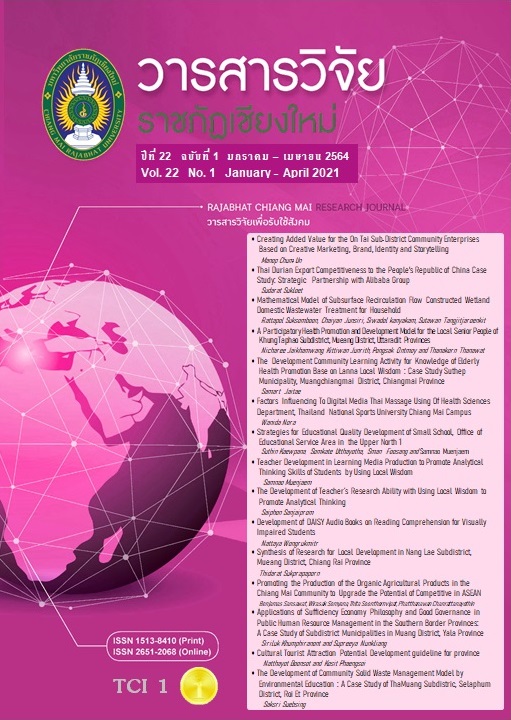แบบจำลองทางคณิตศาสตร์ของระบบบึงประดิษฐ์การไหลเวียนใต้ชั้นกรองในการบำบัดน้ำเสียชุมชนสำหรับที่พักอาศัย
DOI:
https://doi.org/10.14456/rcmrj.2021.240999คำสำคัญ:
แบบจำลองทางคณิตศาสตร์, ระบบบึงประดิษฐ์การไหลเวียนใต้ชั้นกรอง, การบำบัดน้ำเสียชุมชนสำหรับที่พักอาศัยบทคัดย่อ
จากการพัฒนาแบบจำลองแบบพลวัตเครื่องปฏิกรณ์ปลั๊กไหลแบบหมุนเวียน (Recirculation plug-flow reactor :RPFR) ของระบบบำบัดน้ำเสียบึงประดิษฐ์การไหลเวียนใต้ชั้นกรอง (Recirculation surface flow constructed wetland: RSFCW) ใช้ตัวกลางขยะรีไซเคิลพลาสติกบรรจุในถังโพลีเอสเตอร์สจำนวน 3 ถัง มีอัตราส่วนความกว้าง:ความยาว(>1:4) ใช้พื้นที่ปลูกต้นกก (Ap) 1.98 ตร.ม.ความลึกชั้นกรองที่ 25 ซม. อัตราส่วนการหมุนเวียน (Recirculation ratio : QRe/Qin) R=0.85 และเวลากักเก็บหมุนเวียน (Hydraulic recirculation time: HReT) 12 ชั่วโมงในการบำบัดน้ำเสียชุมชนพบว่ามีประสิทธิภาพการกำจัดค่าบีโอดี (Removal BOD efficiency) 81.04% เกิดปฏิกิริยาอันดับ 2 มีค่าสัมประสิทธิ์ของการย่อยสลาย K2ndRPFR เท่ากับ 0.011 day-1 ซึ่งถือได้ว่าเป็นระบบบำบัดอีกทางเลือกที่น่าสนใจสำหรับพักอาศัยในการปลุกจิตใต้สำนึกสำหรับลดภาระทางเทศบาลที่จะต้องจัดสรรงบรัฐบาลในการกำจัดน้ำเสียและขยะพลาสติก
Downloads
เอกสารอ้างอิง
APHA, AWWA, and WEF. (1999). Standard methods for the examination of water and wastewater. USA: American Public Health Association.
Dalila-Haddaji, D., Ghrabi-Gammar, Z., Hamed, K.B., & Bousselmi, L. (2019). A re-circulating horizontal flow constructed wetland for the treatment of synthetic azo dye at high concentrations. Environmental Science and Pollution Research, 26, 13489–13501.
Gross, A., Shmueli, O., Ronen, Z., & Raveh, E. (2007). Recycled vertical flow constructed wetland (RVFCW)—a novel method of recycling greywater for irrigation in small communities and households. Chemosphere, 66, 916–923.
Jaime-Nivalaa, J., Headleyc, T., Wallaced, S., Bernhardb, K., Brixa, H., Afferdenb, M., & MüllerbJaime, R. (2013). Comparative analysis of constructed wetlands: The design and construction of the ecotechnology research facility in Langenreichenbach, Germany. Ecological Engineering, 61, 527–543.
Jeamponk, P. (2012). The Study of Waste Utility and Household Management at Suanluang Sub-Distriet, Amphawa Disstrict, Samut Songkram Province. Retrieved from http://hdl.handle.net/123456789/357 (In Thai).
Kadlec, R. H., ฿ Wallace, S. D. (2009). Treatment Wetlands. (2nded). Boca Raton: CRC Press.
Kaosol, T. (2009). Sustainable Solution for Municipal Solid Waste Management in Thailand. World Academy of Science, Engineering and Technology, 60, 665-670. (In Thai).
Pollution Control Department. (2012). Manual management waste water for households. Pollution Control Department, Ministry of Natural Resources and Environment: Bangkok: Pollution Control Department. (In Thai).
Pollution Control Department. (2016). Manual management waste water for households. Pollution Control Department, Office of Water Quality Management. Bangkok: Pollution Control Department. (In Thai).
Sittiritkawin, P., Treerat, S., Yodkhad, P., & Saengnual, S. (2019). The Study of Waste Management Using Community Participation in Waste Disposal at Baan Pa Koo, Tambon Huai Sak, Amphoe Mueang, Chiang Rai. Rajabhat Chiang Mai Research Journal, 20(2), July–December.
Suksomboon, R. (2007). Design of Water Garden System for City Canal Rehabilitation by Mathematical Model. Thesis in Environmental Engineering, Graduate School, Khon Kaen University. (In Thai).
Suksomboon, R., & Junsiri, C. (2018). The performance of moving fluidized bed bioreactor-granular activated carbon, MFBBR- GAC. Prawarun Agriculture Journal, 15(1), 238-247. (In Thai).
Suksomboon, R., Junsiri, C., Saikaew, W., & Kanyakam, S. (2019a). Mathematical Modeling of Moving Fluidized Bed Bioreactor - Granular Activated Carbon, MFBBR- GAC Domestic Wastewater Treatment for Agricultural Use. Prawarun Agriculture Journal, 16, 259-269. (In Thai).
Suksomboon, R., Junsiri, C., Tangjitjaroenkit, S., Moselhy, M., & Padungthon, P. (2019b). Mathematical models of a fluidized bed bioreactor using granular activated carbon (FBBR-GAC) for wastewater treatment. Engineering and Applied Science Research, 46(3), 183-191.
Xing, W., Ngo, H.H., Guo, W.S., Wu, Z.Q., Nguyen, T.T., Cullum, P., Listowski, A., & Yang,N., (2010). Enhancement of the performance of anaerobic fluidized bed bioreactors (AFBBRs) by a new starch based flocculant. Separation and Purification Technology, 72, 140–146.
ดาวน์โหลด
เผยแพร่แล้ว
รูปแบบการอ้างอิง
ฉบับ
ประเภทบทความ
สัญญาอนุญาต
1. บทความ ข้อมูล เนื้อหา รูปภาพ ฯลฯ ที่ได้รับการตีพิมพ์ใน “Community and Social Development Journal” ถือเป็นลิขสิทธิ์ของ Community and Social Development Journal มหาวิทยาลัยราชภัฏเชียงใหม่ และเพื่อให้เผยแพร่บทความได้อย่างเหมาะสมผ่านสื่อสิ่งพิมพ์และอิเล็กทรอนิกส์ ผู้เขียนยังคงถือครองลิขสิทธิ์บทความที่ตีพิมพ์ภายใต้ใบอนุญาต Creative Commons Attribution (CC BY) ซึ่งอนุญาตให้เผยแพร่บทความซ้ำในแหล่งอื่นได้ โดยอ้างอิงต้องอ้งอิงบทความในวารสาร ผู้เขียนต้องรับผิดชอบในการขออนุญาตผลิตซ้ำเนื้อหาที่มีลิขสิทธิ์จากแหล่งอื่น
2. เนื้อหาบทความที่ปรากฏในวารสารเป็นความรับผิดชอบของผู้เขียนบทความโดยตรง ซึ่งกองบรรณาธิการวารสารไม่จำเป็นต้องเห็นด้วยหรือร่วมรับผิดชอบใดๆ














